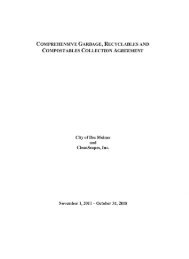CITY OF DES MOINES SHORELINE MASTER PROGRAM
CITY OF DES MOINES SHORELINE MASTER PROGRAM
CITY OF DES MOINES SHORELINE MASTER PROGRAM
You also want an ePaper? Increase the reach of your titles
YUMPU automatically turns print PDFs into web optimized ePapers that Google loves.
Des Moines Shoreline Inventory and Characterization<br />
Table 9. Shoreline Segment “A” Summary<br />
Land Use /<br />
Transportation<br />
Stream<br />
Discharges<br />
Public Shoreline<br />
Access<br />
Hazard Areas<br />
Habitat / Habitat<br />
Potential<br />
Park: 75%, Single-<br />
Family Res.: 17%,<br />
Vacant: 9%; Park<br />
access, foot paths,<br />
beach/auto access<br />
Des Moines<br />
Creek<br />
Des Moines Beach<br />
Park<br />
Erosion, Flood<br />
Wetlands, Stream,<br />
Fish and Wildlife Areas<br />
(Salmonids, shorebirds<br />
and piscivorous birds,<br />
heron rookery, shellfish,<br />
eelgrass)<br />
Shoreline functions within Segment A have been impacted by the following activities:<br />
• Shoreline armoring including riprap (includes mouth of Des Moines Creek) and concrete<br />
bulkheads;<br />
• Removal of marine riparian vegetation;<br />
• Increased impervious surface within the Des Moines Creek basin at a watershed scale;<br />
and<br />
• Changes to the direction of net-shore-drift caused by the Marina (Segment B).<br />
Effects upon the nearshore environment include:<br />
• Sediment supply to nearshore areas cut off by riprap and concrete bulkheads;<br />
• Marine riparian vegetation provides wildlife habitat, microclimates (shade/prey), source<br />
of large woody debris, bank stability, improvements to water quality;<br />
• Subestuaries and deltas depend upon rainfall to bring sediments from upstream to the<br />
nearshore area. High flow rates and volumes resulting from increased runoff from<br />
impervious surface can alter the formation and function of these features; and<br />
• Net-shore drift is the long-term direction of sediment transport along the shoreline. The<br />
construction of the Des Moines Marina (Segment B) has altered this natural process.<br />
Opportunities to improve shoreline functions within Segment A are identified as areas A-1 and<br />
A-2 (Figure 15).<br />
Opportunity Area A-1 and A-2<br />
Opportunities in area A-1 could include the removal of the failing riprap revetment from the<br />
mouth of Des Moines Creek north to the northern City boundary and the removal of riprap from<br />
the mouth of Des Moines Creek. The artificial shoreline could be pulled back a bit with riprap<br />
replaced with alternative “soft shore protection” techniques. Such “biotechnical” or<br />
“bioengineering” techniques could include imported gravel and sand, anchored drift logs or other<br />
large woody debris and , combined with marine riparian plantings along the shoreline and on the<br />
north side of Des Moines Creek. This would allow sediment to migrate from upland areas to the<br />
shoreline, improve subestuary and delta functions, and increase habitat quantity and quality for<br />
both terrestrial and aquatic animals using the shoreline, as well as expanded beach recreation.<br />
Page 40 March 2005



